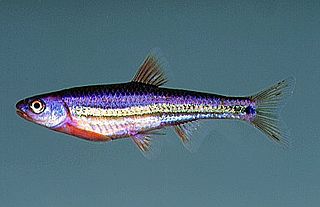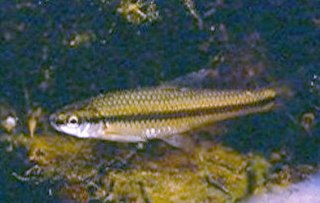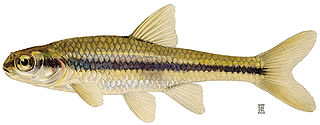
The emerald shiner is one of hundreds of small, silvery, slender fish species known as shiners. The identifying characteristic of the emerald shiner is the silvery emerald color on its sides. It can grow to 3.5 inches in length and is found across North America from Canada to the Gulf of Mexico, commonly in large, deep lakes and rivers, though sometimes in smaller bodies of water as well. It feeds on small organisms such as zooplankton and insects, congregating in large groups near the surface of the water. It is a quite common fish and is often used as a bait fish.

Notropis is a genus of freshwater fish in the family Cyprinidae. They are known commonly as eastern shiners. They are native to North America, and are the continent's second largest genus.

The smalleye shiner is a species of ray-finned fish in the family Cyprinidae. It is found only in the upper Brazos River basin of Texas, which includes the Double Mountain and Salt forks of the upper Brazos. It became a candidate for federal listing as an endangered species of the United States in 2013.

The Cape Fear shiner is a North American species of freshwater fish in the family Cyprinidae. It is endemic to the central part of the state of North Carolina in the southeastern United States, and is only found in the shallow streams of the Cape Fear River basin. The fish is small and yellow with black lips and a black stripe that runs down the middle of the fish's side. This shiner is normally found in mixed schools with other minnow species. It is unique amongst its genus because it has elongated intestines that are specifically adapted to a primarily herbivorous diet. It can breed twice a year and normally lives for only two or three years in the wild. The males and females are normally similar in appearance but become different colors in the spawning season. This species of shiner was not discovered until 1962.

The bridle shiner is a member of the minnow family (Cyprinidae). This species has been identified as being of Special Concern by the Committee on the Status of Endangered Wildlife in Canada (COSEWIC).

The sand shiner is a widespread North American species of freshwater fish in the family Cyprinidae. Sand shiners live in open clear water streams with sandy bottoms where they feed in schools on aquatic and terrestrial insects, bottom ooze and diatoms.

The palezone shiner is a rare species of ray-finned fish in the family Cyprinidae. It is native to Alabama and Kentucky in the United States. It once occurred in Tennessee, but it has been extirpated from the state. There are two populations remaining. It is a federally listed endangered species of the United States.

The Texas shiner is a species of ray-finned fish in the genus Notropis. It is found in the Colorado River to Rio Grande drainage from Texas and northeastern Mexico and the Rio Salado and Rio San Juan systems in Mexico to the lower Pecos River in Texas.

The pugnose shiner is a species of ray-finned fish in the genus Notropis. It is in the family Cyprinidae which consists of freshwater carps and minnows. Cyprinidae is the largest fish family which consists of about 369 genera and 3,018 species. Its distribution has been decreasing due to the removal of aquatic plants in order to create swimming beaches and boating access in freshwater lakes and is now mostly found in Minnesota, Wisconsin, and Michigan.
The bigeye shiner is a species of ray-finned fish in the genus Notropis. This fish is a slender, silvery minnow with a dusky lateral stripe and a maximum total length of about 80 mm. Its distinct characteristic is its large-diameter eyes. It is a common species in upland streams of the middle Mississippi River system. Bigeye shiners prefer warm, quiet pools with clear water and silt-free substrates. Siltation, channelization, and gravel dredging are all threats to bigeye shiner populations. During spawning season, typically late April to August, bigeye shiners have several clutches of eggs. State agencies and the EPA have both played a role in the surveying of bigeye shiner populations. Populations have decreased in Ohio due mostly to habitat destruction. In addition to habitat destruction by humans, habitat alteration of the small streams and dried pools has also had a significant effect on abundance. Rivers and streams should not be channelized or modified in any way, which is becoming an increasingly popular trend in urban locations. Agricultural areas and properties within the watershed should adhere to regulations to prevent runoff into the streams.

The spottail shiner or spottail minnow is a small- to medium-sized freshwater minnow. It can be found as far north as Canada and as far south as the Chattahoochee River in Georgia. These shiners live in lakes, rivers, and creeks. They occupy the rocky or sandy shorelines and bottoms of the water. One of the defining features of a spottail shiner is the black spot found at the base of the caudal fin. These shiners generally spawn from late June through July.
The carmine shiner is a freshwater fish species. In Manitoba, it was once known as the rosyface shiner. It is now recognized as a different species within the rosyface shiner species complex, largely based on zoogeographic information. The carmine shiner is a member of the Minnow family, Cyprinidae. It has the following characteristics and distinguishing features:

The mimic shiner is a species of North American cyprinid freshwater fish in the genus Notropis. The genus Notropis is commonly known as the eastern shiners. It is native to areas of the Hudson Bay drainage, Great Lakes drainage, much of the Mississippi River basin including areas of Tennessee, Virginia, North Carolina, and regions of the Gulf of Mexico extending from Mobile Bay to the drainage of Texas. However, this particular species can be found in other places such as the Atlantic Coast drainage in Connecticut and Housatonic rivers. This genus is usually characterized by almost all having a complete lateral line, 8 dorsal fin rays, a premaxillae protactile, and a silvery or speckled peritoneum. As the common name indicates, this species is difficult to classify in the wild because it looks similar to many other shiners. In fact, some even hypothesize that this species is actually a complexity of many cryptic species. While this is the case, it is important to take more caution to not misidentify this species and to understand its impact on introduced areas.

The ghost shiner is a North American species of freshwater fish of the family Cyprinidae. It is generally characterized as being a small bodied, silvery and fusiform shaped cyprinid. Notropis buchanani is morphologically similar to and often mistaken for the Mimic Shiner, which is evident by its former classification as a subspecies of Notropis volucellus.

The ironcolor shiner is a species of freshwater ray-finned fish from the family Cyprinidae, the minnows and carps. It is a widespread species in streams and rivers in eastern North America.

The red shiner or red-horse minnow is a North American species of freshwater fish in the family Cyprinidae. They are deep-bodied and laterally compressed, and can grow to about three inches in length. For most of the year, both males and females have silver sides and whitish abdomens. Males in breeding coloration, though, have iridescent pink-purple-blue sides and a red crown and fins.

The North Fork Double Mountain Fork Brazos River is an intermittent stream about 75 mi (121 km) long, heading at the junction of Blackwater Draw and Yellow House Draw in the city of Lubbock, flowing generally southeastward to its mouth on the Double Mountain Fork Brazos River in western Kent County. It crosses portions of Lubbock, Crosby, Garza, and Kent counties in West Texas.

The blacktail shiner is a small freshwater fish in the family Cyprinidae native to the United States.
The scarlet shiner is a freshwater fish native to the eastern United States.

















